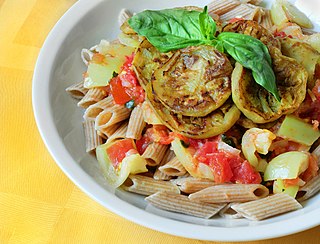
Aspartame is an artificial non-saccharide sweetener 200 times sweeter than sucrose and is commonly used as a sugar substitute in foods and beverages. It is a methyl ester of the aspartic acid/phenylalanine dipeptide with brand names NutraSweet, Equal, and Canderel. Aspartame was approved by the US Food and Drug Administration (FDA) in 1974, and then again in 1981, after approval was revoked in 1980.

Sugar is the generic name for sweet-tasting, soluble carbohydrates, many of which are used in food. Simple sugars, also called monosaccharides, include glucose, fructose, and galactose. Compound sugars, also called disaccharides or double sugars, are molecules made of two bonded monosaccharides; common examples are sucrose, lactose, and maltose. White sugar is a refined form of sucrose. In the body, compound sugars are hydrolysed into simple sugars.

Confectionery is the art of making confections, which are food items that are rich in sugar and carbohydrates. Exact definitions are difficult. In general, however, confectionery is divided into two broad and somewhat overlapping categories: bakers' confections and sugar confections. The occupation of confectioner encompasses the categories of cooking performed by both the French patissier and the confiseur.

Sucralose is an artificial sweetener and sugar substitute. As the majority of ingested sucralose is not metabolized by the body, it adds no calories. In the European Union, it is also known under the E number E955. It is produced by chlorination of sucrose, selectively replacing three of the hydroxy groups—in the C1 and C6 positions of the fructose portion and the C4 position of the glucose portion—to give a 1,6-dichloro-1,6-dideoxyfructose–4-chloro-4-deoxygalactose disaccharide. Sucralose is about 600 times sweeter than sucrose, three times as sweet as both aspartame and acesulfame potassium, and twice as sweet as sodium saccharin.

Splenda is a global brand of sugar substitutes and reduced-calorie food products. While the company is known for its original formulation containing sucralose, it also manufactures items using natural sweeteners such as stevia, monk fruit and allulose. It is owned by the American company Heartland Food Products Group. The high-intensity sweetener ingredient sucralose used in Splenda Original is manufactured by the British company Tate & Lyle.

Fructose, or fruit sugar, is a ketonic simple sugar found in many plants, where it is often bonded to glucose to form the disaccharide sucrose. It is one of the three dietary monosaccharides, along with glucose and galactose, that are absorbed by the gut directly into the blood of the portal vein during digestion. The liver then converts both fructose and galactose into glucose, so that dissolved glucose, known as blood sugar, is the only monosaccharide present in circulating blood.

A sugar substitute is a food additive that provides a sweetness like that of sugar while containing significantly less food energy than sugar-based sweeteners, making it a zero-calorie or low-calorie sweetener. Artificial sweeteners may be derived through manufacturing of plant extracts or processed by chemical synthesis. Sugar substitute products are commercially available in various forms, such as small pills, powders, and packets.

Acesulfame potassium, also known as acesulfame K or Ace K, is a synthetic calorie-free sugar substitute often marketed under the trade names Sunett and Sweet One. In the European Union, it is known under the E number E950. It was discovered accidentally in 1967 by German chemist Karl Clauss at Hoechst AG. In chemical structure, acesulfame potassium is the potassium salt of 6-methyl-1,2,3-oxathiazine-4(3H)-one 2,2-dioxide. It is a white crystalline powder with molecular formula C
4H
4KNO
4S and a molecular weight of 201.24 g/mol.

Diet or light beverages are generally sugar-free, artificially sweetened beverages with few or no calories. They are marketed for diabetics and other people who want to reduce their sugar and/or caloric intake.

Erythritol (, ) is an organic compound, the naturally occurring achiral meso four-carbon sugar alcohol (or polyol). It is the reduced form of either D- or L-erythrose and one of the two reduced forms of erythrulose. It is used as a food additive and sugar substitute. It is synthesized from corn using enzymes and fermentation. Its formula is C
4H
10O
4, or HO(CH2)(CHOH)2(CH2)OH.

Sweet'n Low is a brand of artificial sweetener now made primarily from granulated saccharin. When introduced in 1958 in the United States, Sweet'n Low was cyclamate-based, but it was replaced by a saccharin-based formulation in 1969. It is also a brand name applied to a family of sweetener and sweetened products, some containing sweeteners other than saccharin or cyclamate. There have been over 500 billion Sweet'N Low packets produced.

Tagatose is a hexose monosaccharide. It is found in small quantities in a variety of foods, and has attracted attention as an alternative sweetener. It is often found in dairy products, because it is formed when milk is heated. It is similar in texture and appearance to sucrose :215 and is 92% as sweet,:198 but with only 38% of the calories.:209 Tagatose is generally recognized as safe by the Food and Agriculture Organization and the World Health Organization, and has been since 2001. Since it is metabolized differently from sucrose, tagatose has a minimal effect on blood glucose and insulin levels. Tagatose is also approved as a tooth-friendly ingredient for dental products. Consumption of more than about 30 grams of tagatose in a dose may cause gastric disturbance in some people, as it is mostly processed in the large intestine, similar to soluble fiber.:214

High-fructose corn syrup (HFCS), also known as glucose–fructose, isoglucose and glucose–fructose syrup, is a sweetener made from corn starch. As in the production of conventional corn syrup, the starch is broken down into glucose by enzymes. To make HFCS, the corn syrup is further processed by D-xylose isomerase to convert some of its glucose into fructose. HFCS was first marketed in the early 1970s by the Clinton Corn Processing Company, together with the Japanese Agency of Industrial Science and Technology, where the enzyme was discovered in 1965.

D-Psicose (C6H12O6), also known as D-allulose, or simply allulose, is a low-calorie epimer of the monosaccharide sugar fructose, used by some major commercial food and beverage manufacturers as a low-calorie sweetener. First identified in wheat in the 1940s, allulose is naturally present in small quantities in certain foods.

Diet food refers to any food or beverage whose recipe is altered to reduce fat, carbohydrates, and/or sugar in order to make it part of a weight loss program or diet. Such foods are usually intended to assist in weight loss or a change in body type, although bodybuilding supplements are designed to increase weight.

Cumberland Packing Corporation is a privately owned company located at 2 Cumberland Street, in Brooklyn, New York City. It was founded in 1945 by Benjamin Eisenstadt and is best known as the manufacturer, distributor, and marketer of Sweet'n Low, the saccharin-based zero-calorie sweetener sold in pink packets.

Agave syrup, also known as maguey syrup or agave nectar, is a sweetener commercially produced from several species of agave, including Agave tequilana and Agave salmiana. Blue-agave syrup contains 56% fructose as a sugar providing sweetening properties.

Pentadin, a sweet-tasting protein, was discovered and isolated in 1989, in the fruit of oubli, a climbing shrub growing in some tropical countries of Africa. Sweet tasting proteins are often used in the treatment of diabetes, obesity, and other metabolic disorders that one can experience. These proteins are isolated from the pulp of various fruits, typically found in rain forests and are also used as low calorie sweeteners that can enhance and modify existing foods.
Truvia is a brand of stevia-based sugar substitute developed jointly by The Coca-Cola Company and Cargill. It is distributed and marketed by Cargill as a tabletop sweetener as well as a food ingredient. Truvia is made of stevia leaf extract, erythritol, and natural flavors. Because it comes from the stevia plant, Cargill classifies Truvia as a natural sweetener in addition to being a non-nutritive sweetener, although Cargill has settled lawsuits alleging deceptive marketing of Truvia as "natural". Since its launch in 2008, Truvia natural sweetener has become the second best-selling sugar substitute in units in the U.S. behind Splenda, surpassing Equal and Sweet'n Low. Truvia competes with Stevia In The Raw, the #2 brand of stevia, owned by Cumberland Packaging who also makes Sweet 'n Low.

Added sugars or free sugars are sugar carbohydrates added to food and beverages at some point before their consumption. These include added carbohydrates, and more broadly, sugars naturally present in honey, syrup, fruit juices and fruit juice concentrates. They can take multiple chemical forms, including sucrose, glucose (dextrose), and fructose.



















